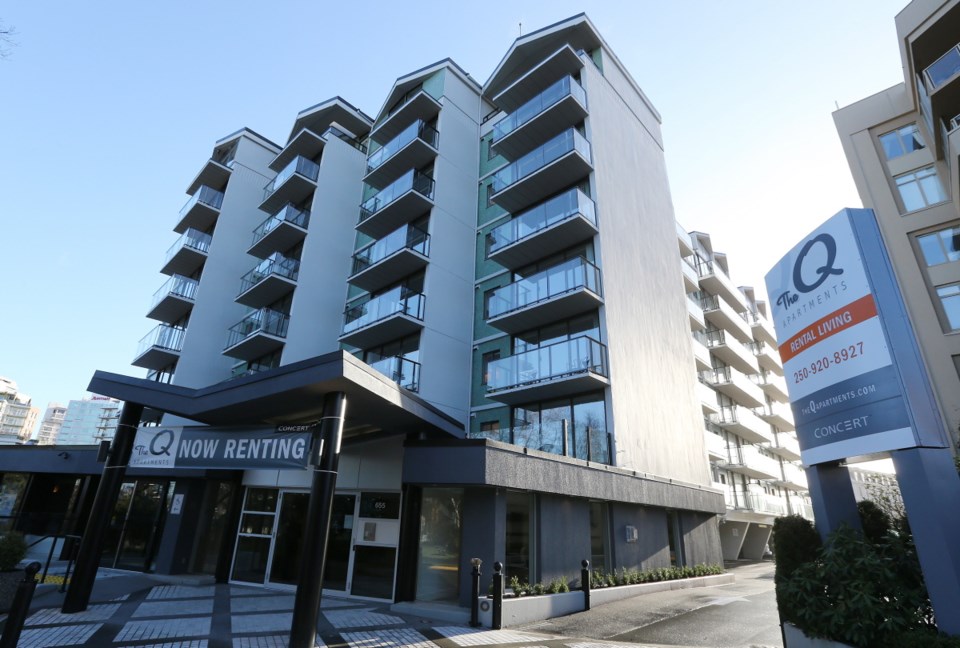Greater Victoria’s spring rental vacancy rate has tightened to its lowest level since 2009.
The capital region’s vacancy rate in private, purpose-built apartments was 1.2 per cent in April, compared with 2.7 in the same month a year ago, Canada Mortgage and Housing said in its spring report.
“Vacancy rates moved lower this spring as increased rental demand outpaced additions to rental supply,” said Carol Frketich, B.C. regional economist for CMHC. Provincewide, 1.8 per cent of rental units were vacant, down from 2.4 per in April 2014, the report said.
Greater Victoria’s vacancy rate dropped despite construction of rental units in the past two years, CMHC said. But those new units added just 245 units out of the 24,072 in the region. And with increasing migration factored in, the vacancy rate dropped.
One-bedroom apartments, representing more than half of the purpose-built units, have a vacancy rate of one per cent, the federal agency said.
Victoria’s vacancy rate is among the lowest in the province, on par with Courtenay. Parksville is lowest at one per cent, while Dawson Creek is the highest at 8.9 per cent.
Russ Godfrey, Victoria representative of the Tenant Resource and Advisory Centre, said the rate may have loosened up now that students are out of school. Even so, the region is facing an affordable rental housing “crisis,” he said.
If there’s an opening, “we have people just scrambling all over each other to try and get these apartments.”
Anything in the $500- to $700-per-month range is snapped up immediately, Godfrey said.
He praised Victoria for its Mayor’s Task Force on Housing Affordability, but said all municipalities should be pitching in. The task force’s recommendations are slated to go to council on July 16.
A tight rental market hurts the entire economy, Godfrey said, adding, “How do you attract a skilled workforce here?”
The average rental rate for a two-bedroom apartment for new and existing structures is $1,105 per month in the capital region. That’s up from $1,084 last year.
David Hutniak, chief executive of LandlordBC, said because the spring CMHC measurement does not include all types of rental units, such as townhouses for example, he figures the rate is probably closer to 1.9 to two per cent, adding that is still a low rate.
There is a “huge need” for new purpose-built rental units, said Hutniak.
Some cities have helped create rental housing by allowing more density, decreasing parking requirements and lowering development fees, he said, adding that an expedited approval process for construction projects is key.
Meanwhile, the rental market tightened in Vancouver to 1.4 per cent, from 1.8 per cent a year ago.
To the east, demand for rental apartments weakened due to the decline in the oil price. The number of rental apartments that sat vacant in April climbed to 3.2 per cent in Calgary and 2.4 per cent in Edmonton. Both cities had rental vacancy rates of 1.4 per cent a year earlier.
Regina’s rental vacancy rate climbed to 4.8 per cent in April, from 2.5 per cent a year ago.
Toronto’s vacancy rate remained flat, at 1.8 per cent.
Renters in Vancouver paid the highest average rent for a two-bedroom apartment, at $1,345 per month. Calgary was second at $1,319, followed by Toronto at $1,269.
CMHC chief economist Bob Dugan said stronger economic conditions in Ontario and B.C. offset the negative impact of energy prices in Western Canada, leaving the national average vacancy rate flat in April at 2.9 per cent.
“In Ontario, improving employment conditions for young adults placed downward pressure on vacancy rates, while increased immigration to B.C. more than offset an increase in the province’s rental market supply,” Dugan said.



